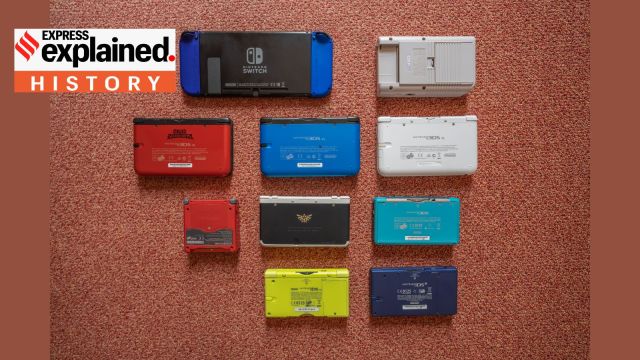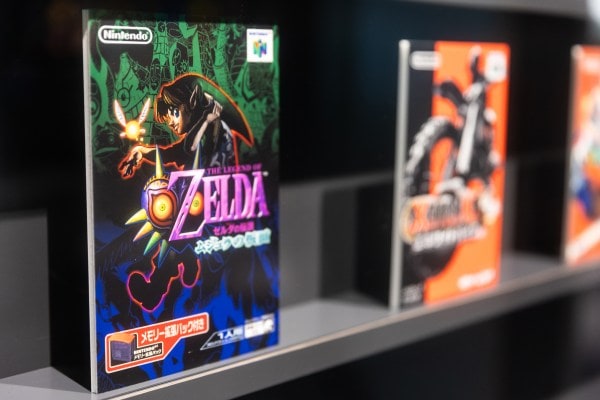Story of Nintendo: How a company that made handcrafted playing cards became a billion dollar tech giant
The Japanese company, most known for its video games and consoles, was founded in 1889. Today, it boasts a market cap of almost $90 billion
 A collection of Nintendo gaming devices over the years. (Wikimedia Commons)
A collection of Nintendo gaming devices over the years. (Wikimedia Commons)Japanese video game company Nintendo on Wednesday announced it will release the much-awaited Switch 2 on June 5, at a starting price of $449.99.
Switch 2 is arriving seven years after the launch of the original Switch, which has gone on to become the third best-selling video game console in history, behind Sony’s PlayStation 2 and the Nintendo DS.
Founded in 1889 as a company that produced handcrafted playing cards, Nintendo today is one of the most successful tech firms today, both in terms of innovation and longevity. Here is its story.
Humble beginnings
As far as tech companies go, Nintendo has the most unlikely beginnings.
It was founded on September 23, 1889 by businessman and crafter Fusajiro Yamauchi as a small shop on a narrow side street in the ancient city of Kyoto. The shop used to sell beautifully decorated hand-made playing cards, known as Hanafuda. They are typically smaller than archetypal Western cards, and feature natural scenes and symbols, instead of numbers.
 Hanafuda playing cards on display at the new Nintendo Museum in Kyoto, Japan, Sept. 24, 2024. (Shiho Fukada/The New York Times)
Hanafuda playing cards on display at the new Nintendo Museum in Kyoto, Japan, Sept. 24, 2024. (Shiho Fukada/The New York Times)
As his cards’ popularity grew across Japan, Yamauchi had to hire staff to help keep up with demand. They soon came to be associated with the Yakuza, transnational Japanese crime syndicates, which were involved in a number of illegal activities, including gambling.
“The name ‘Yakuza’ actually comes from the numbers ya-ku-za or 8, 9 and 3; a zero score in a card game known as Oicho-Kabu… Members of the Yakuza even have tattoos that are inspired by the illustrations on the Nintendo cards,” according to an article in the BBC.
It was not until the 1960s that Nintendo’s cards fell out of favour, forcing the company to change its direction.
Foray into video games
Hiroshi Yamauchi, Fusajiro’s great-grandson, took over the reins of Nintendo in 1949, at the age of only 22. He had the reputation of being a fierce leader, but also a passionate and innovative thinker.
It is under Hiroshi that Nintendo expanded beyond playing cards, although not with much success in the beginning. Nintendo’s foray into instant rice — perhaps an attempt to piggyback on the recent success of instant noodles — was a miserable failure. As was its foray into love hotels. Nintendo’s taxi service and robotic vacuum cleaner business fared better, but did not stay afloat for long.
The company eventually struck gold in the 1970s after it made investments in a fast-emerging technology: video games. By 1978, Nintendo was able to produce an electronic game version of the popular board game Othello. This was a tabletop single and multiplayer video game that was never released outside of Japan.
It was with the arcade video game Donkey Kong that Nintendo in 1981 got its first international hit. The game featured a giant gorilla (Donkey Kong) as the villain, who had kidnapped the girlfriend of his owner, an Italian plumber called Mario.
“Donkey Kong was a hit (across the world). It was also a milestone in video game history: the first of the so-called platform games, and one of the first to have a substantial narrative, along with a sense of humour,” an article in the Time magazine said.
 The Legend of Zelda: Majora’s Mask on display at the new Nintendo Museum in Kyoto, Japan, Sept. 24, 2024 (Shiho Fukada/The New York Times)
The Legend of Zelda: Majora’s Mask on display at the new Nintendo Museum in Kyoto, Japan, Sept. 24, 2024 (Shiho Fukada/The New York Times)
Nintendo created other popular games such as Donkey Kong Jr (in which the son of Donkey Kong had to free his father from the clutches of Mario), The Legend of Zelda, and Super Mario Bros.
Advent of the console era
Buoyed by the success of these games, the company launched a new home game console known as the Family Computer (Famicom) on July 15, 1983. Two years later, Nintendo introduced it in the United States under the moniker of Nintendo Entertainment System (NES).
Nintendo sold 61.91 million units of NES worldwide, helping the gaming industry recover from the video game crash of 1983 in the US. (The collapse was caused by market saturation and poor quality products, among other factors).
In 1989, the company released its first handheld game console, the Game Boy. This was a milestone in gaming history, and became very popular due to its unique design, affordability, and long battery life.
Nintendo’s most-selling console to date — the Nintendo DS — came in 2004. It featured a distinct dual-screen design, with a touchscreen at the bottom. This “allowed for new forms of gameplay and interaction, opening possibilities for touch-based controls, stylus input, and dual-screen experiences,” according to a report by TechInsight. The console revolutionised handheld gaming, and Nintendo sold around 154 million units.
The company witnessed a dip in its fortunes after launching the Wii U console in 2012. This was the successor of the pathbreaking Wii console, which came with a slim wand (resembling a TV remote) equipped with an innovative motion sensor. But due to poor marketing, weak third-party developer support, and underpowered hardware, Wii U failed to impress users.
Fewer than 15 million units were sold before it was discontinued in 2017. But the very same year, Nintendo released the Switch, which had a unique hybrid design. It could be used as a traditional home console, where it was connected to a monitor or TV, or it could be used as a portable handheld console. This allowed the Switch to target two markets simultaneously.
Behind the success
Nintendo’s enduring success primarily stems from its ability to keep its hardware costs down, and create appealing games. Essentially, the company strives to get the most possible fun out of relatively modest hardware.
Florent Gorges, a French author who has written books on Nintendo’s history, calls this “lateral thinking”. He told France24: “The Switch perfectly respects Nintendo’s DNA, which is ‘lateral thinking with withered technology’. This means to succeed in making something new out of something old.”
Nintendo also has a great appetite for experimenting. For instance, it once created an ingenious piece of software that turned cardboard models into playable tech toys. And even when some of its products failed, the company avoided firing executives and revamping its whole strategy.
Chris Kohler, author of Power-Up: How Japanese Video Games Gave the World an Extra Life (2005), told The Guardian, “Nintendo has been great at growing and retaining talent and ensuring that continuity of game design know-how… The fact that Nintendo still makes hardware is extremely important, as they can create these great experiences to grow their own ecosystem without having to chase after the latest trends.”
More Explained
Must Read


EXPRESS OPINION
Apr 26: Latest News
- 01
- 02
- 03
- 04
- 05

























